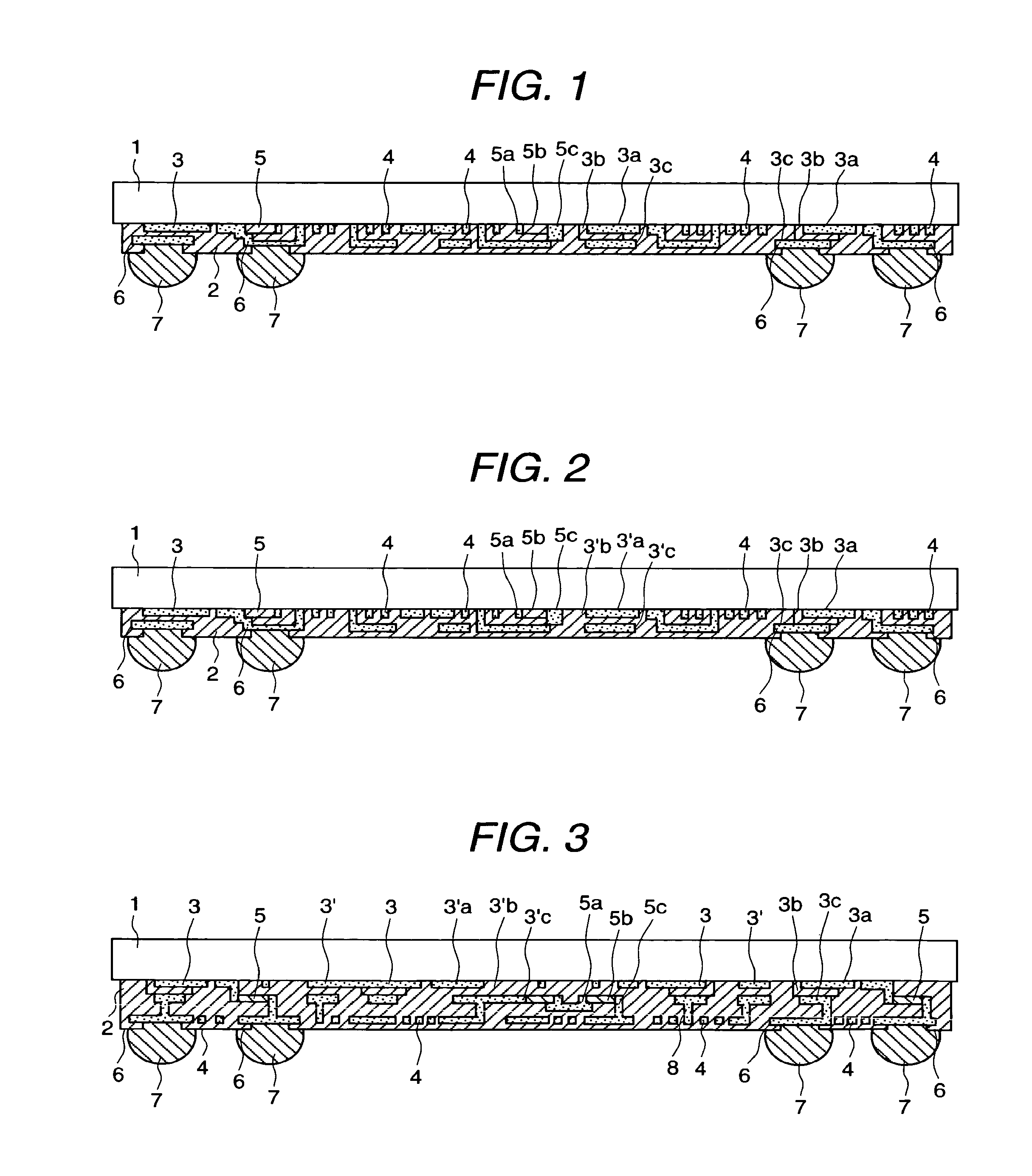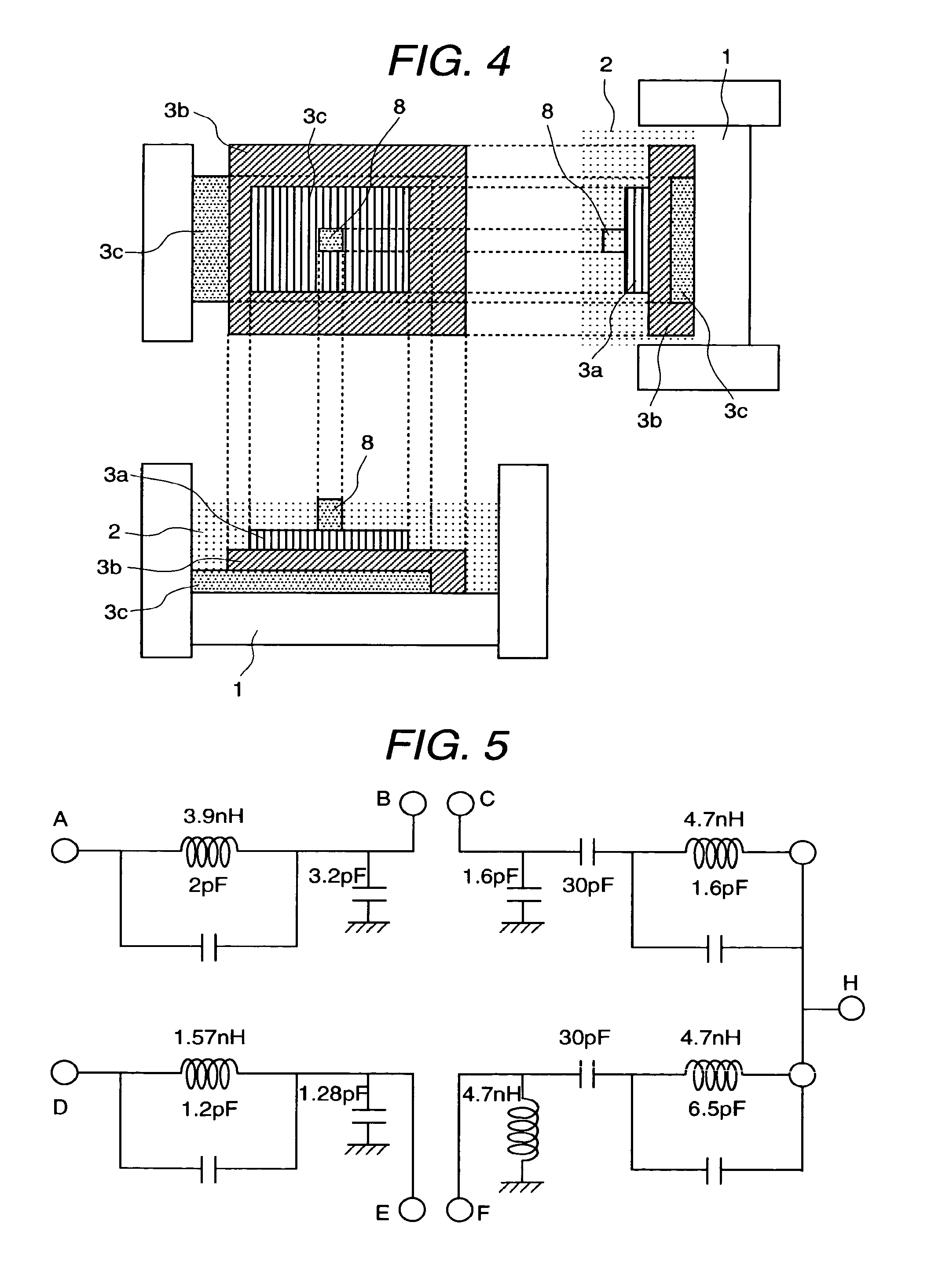Electronic circuit component
a technology of electronic circuit components and components, applied in the field of electronic components, can solve the problems of low wiring, low use property of silicon substrates, and difficulty in mounting electronic parts in high density, and achieve the effects of enhancing efficiency and performance, cost reduction, and enhancing manufacturing yield
- Summary
- Abstract
- Description
- Claims
- Application Information
AI Technical Summary
Benefits of technology
Problems solved by technology
Method used
Image
Examples
embodiment 1
[0078]FIG. 1 is a cross sectional view of an electronic circuit component representing one embodiment of the present invention. In FIG. 1, 1 is a glass substrate (product of Nippon Electric Glass Co., Ltd., BLC), and the thickness of which is 0.5 mm.
[0079]In FIG. 1, 2 is an organic insulator and photosensitive polyimide (product of Hitachi Chemical Co., Ltd., HD-6000) is used therefor.
[0080]A capacitor element 3 formed inside the organic insulator 2 is in a three layer structure constituted by a lower electrode 3a , a dielectric body 3b and an upper electrode 3c. The lower electrode 3a is composed by Cu, the dielectric body 3b by oxide of Ta and the upper electrode 3c by Cu.
[0081]An inductor element 4 is a spiral type inductor and is formed on the same plane as the upper electrode 3c of the capacitor element 3 and the material thereof is Cu.
[0082]A resistor 5 is constituted by a resistance body 5b and electrodes 5a and 5c. The resistance body 5b is a compound of Ta and Ti and the el...
embodiment 2
[0099]In embodiment 2, in place of the glass substrate 1 used in embodiment 1 in FIG. 1, the following glass substrate was used. The composition of the glass substrate of the present embodiment contains at least one rare earth element selected among the group including Sc, Y, La, Pr, Nd, Pm, Sm, Eu, Gd, Tb, Dy, Ho, Er, Tm, Yb and Lu in an amount of 0.5-20 weight % with respect to the entire glass components when converted based on oxide of Ln2O3 (Ln is a rare earth element) and as the other components contains SiO2:40˜80 weight %, B2O3:0˜20 weight %, R2O (R2 is alkali metal):020 weight %, RO (R is alkaline earth metal):0˜20 weight % and Al2O3:0˜17 weight %, and it is preferable that R2O+RO are contained in an amount of 10˜30 weight %. Further, the thickness thereof was 0.5 mm like embodiment 1.
[0100]Further, the portions other than the glass substrate 1 in the present embodiment are the same as those in embodiment 1.
[0101]Further, the manufacturing method of the electronic circuit c...
embodiment 3
[0105]In embodiment 3, in place of the photosensitive polyimide used in embodiment 1, BCB (product of Dow Chemical, Cycloten 4026) was used as the organic insulator 2.
[0106]Further, the portions other than the organic insulator 2 in the present embodiment are the same as those in embodiment 1.
[0107]Further, the manufacturing method of the electronic circuit component of the present embodiment is the same as that of embodiment 1.
[0108]The dielectric constant and dielectric loss tangent of BCB are respectively 2.65 and 0.003, which are respectively smaller than 3.5 and 0.01 of the photosensitive polyimide.
[0109]Accordingly, by using BCB as an insulator layer which covers the circumference of the electronic parts, the conductive loss and dielectric loss are reduced, thereby, loss of signals passing through the electronic parts can be reduced.
[0110]Through the use of BCB for the organic insulator in the present embodiment, the conductive loss and dielectric loss are reduced, thereby, an...
PUM
| Property | Measurement | Unit |
|---|---|---|
| thickness | aaaaa | aaaaa |
| resistivity | aaaaa | aaaaa |
| thickness | aaaaa | aaaaa |
Abstract
Description
Claims
Application Information
 Login to View More
Login to View More - R&D
- Intellectual Property
- Life Sciences
- Materials
- Tech Scout
- Unparalleled Data Quality
- Higher Quality Content
- 60% Fewer Hallucinations
Browse by: Latest US Patents, China's latest patents, Technical Efficacy Thesaurus, Application Domain, Technology Topic, Popular Technical Reports.
© 2025 PatSnap. All rights reserved.Legal|Privacy policy|Modern Slavery Act Transparency Statement|Sitemap|About US| Contact US: help@patsnap.com



